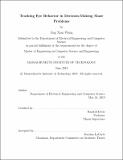Tracking eye behavior in decision-making maze problems
Author(s)
Wang, Jing Xian,M. Eng.Massachusetts Institute of Technology.
Download1128185885-MIT.pdf (2.739Mb)
Other Contributors
Massachusetts Institute of Technology. Department of Electrical Engineering and Computer Science.
Advisor
Randall Davis.
Terms of use
Metadata
Show full item recordAbstract
Neurodegenerative diseases, such as Alzheimer's and Huntington's, can significantly impact a patient's ability to solve everyday problems. The ability to detect early signs of mental decline is crucial for determining whether someone might be at risk for these diseases. Eye behavior is often correlated to cognitive load, so examining the behavior of the eyes during decision-making tasks could provide us with insights on how individuals think when solving challenging problems. But eye tracking data is notoriously noisy, so developing methods for cleaning, parsing, and visualizing the data is important for understanding what it means. By conducting eye tracking studies on healthy individuals using mazes of various difficulty levels and characteristics, I was able to gather, process, and examine gaze data to investigate patterns in eye behavior during decision-making problems.
Description
This electronic version was submitted by the student author. The certified thesis is available in the Institute Archives and Special Collections. Thesis: M. Eng. in Computer Science and Engineering, Massachusetts Institute of Technology, Department of Electrical Engineering and Computer Science, 2019 Cataloged from student-submitted PDF version of thesis. Includes bibliographical references (pages 67-68).
Date issued
2019Department
Massachusetts Institute of Technology. Department of Electrical Engineering and Computer SciencePublisher
Massachusetts Institute of Technology
Keywords
Electrical Engineering and Computer Science.